Knee arthroplasty in Denmark, Norway and Sweden. A pilot study from the Nordic Arthroplasty Register Association
- PMID: 20180723
- PMCID: PMC2856209
- DOI: 10.3109/17453671003685442
Knee arthroplasty in Denmark, Norway and Sweden. A pilot study from the Nordic Arthroplasty Register Association
Abstract
Background and purpose: The number of national arthroplasty registries is increasing. However, the methods of registration, classification, and analysis often differ.
Methods: We combined data from 3 Nordic knee arthroplasty registers, comparing demographics, methods, and overall results. Primary arthroplasties during the period 1997-2007 were included. Each register produced a dataset of predefined variables, after which the data were combined and descriptive and survival statistics produced.
Results: The incidence of knee arthroplasty increased in all 3 countries, but most in Denmark. Norway had the lowest number of procedures per hospital-less than half that of Sweden and Denmark. The preference for implant brands varied and only 3 total brands and 1 unicompartmental brand were common in all 3 countries. Use of patellar button for total knee arthroplasty was popular in Denmark (76%) but not in Norway (11%) or Sweden (14%). Uncemented or hybrid fixation of components was also more frequent in Denmark (22%) than in Norway (14%) and Sweden (2%). After total knee arthroplasty for osteoarthritis, the cumulative revision rate (CRR) was lowest in Sweden, with Denmark and Norway having a relative risk (RR) of 1.4 (95% CI: 1.3-1.6) and 1.6 (CI: 1.4-1.7) times higher. The result was similar when only including brands used in more than 200 cases in all 3 countries (AGC, Duracon, and NexGen). After unicompartmental arthroplasty for osteoarthritis, the CRR for all models was also lowest in Sweden, with Denmark and Norway having RRs of 1.7 (CI: 1.4-2.0) and 1.5 (CI: 1.3-1.8), respectively. When only the Oxford implant was analyzed, however, the CRRs were similar and the RRs were 1.2 (CI: 0.9-1.7) and 1.3 (CI: 1.0-1.7).
Interpretation: We found considerable differences between the 3 countries, with Sweden having a lower revision rate than Denmark and Norway. Further classification and standardization work is needed to permit more elaborate studies.
Figures


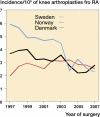


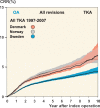
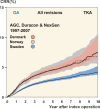
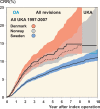
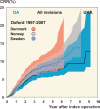
Similar articles
-
Impact of Nordic Arthroplasty Register Association (NARA) collaboration on demographics, methods and revision rates in knee arthroplasty: a register-based study from NARA 2000-2017.Acta Orthop. 2022 Nov 28;93:866-873. doi: 10.2340/17453674.2022.5256. Acta Orthop. 2022. PMID: 36445098 Free PMC article.
-
The Nordic Arthroplasty Register Association: a unique collaboration between 3 national hip arthroplasty registries with 280,201 THRs.Acta Orthop. 2009 Aug;80(4):393-401. doi: 10.3109/17453670903039544. Acta Orthop. 2009. PMID: 19513887 Free PMC article.
-
A Scandinavian experience of register collaboration: the Nordic Arthroplasty Register Association (NARA).J Bone Joint Surg Am. 2011 Dec 21;93 Suppl 3:13-9. doi: 10.2106/JBJS.K.00951. J Bone Joint Surg Am. 2011. PMID: 22262418
-
Hemiarthroplasties after hip fractures in Norway and Sweden: a collaboration between the Norwegian and Swedish national registries.Hip Int. 2014 May-Jun;24(3):223-30. doi: 10.5301/hipint.5000105. Epub 2014 Feb 3. Hip Int. 2014. PMID: 24500828 Free PMC article. Review.
-
Outcomes of different bearings in total hip arthroplasty - implant survival, revision causes, and patient-reported outcome.Dan Med J. 2017 Mar;64(3):B5350. Dan Med J. 2017. PMID: 28260601 Review.
Cited by
-
Secondary Patellar Resurfacing after Primary Bicondylar Knee Arthroplasty did Not Meet Patients' Expectations.Open Orthop J. 2012;6:414-8. doi: 10.2174/1874325001206010414. Epub 2012 Sep 7. Open Orthop J. 2012. PMID: 23002412 Free PMC article.
-
[The 2-year follow-up results of a patient-specific interpositional knee implant].Orthopade. 2011 Dec;40(12):1103-10. doi: 10.1007/s00132-011-1790-x. Orthopade. 2011. PMID: 21713581 German.
-
Bone cement product and failure in total knee arthroplasty.Acta Orthop. 2017 Feb;88(1):75-81. doi: 10.1080/17453674.2016.1256937. Epub 2016 Nov 14. Acta Orthop. 2017. PMID: 27841713 Free PMC article.
-
Ipsilateral lower extremity joint involvement increases the risk of poor pain and function outcomes after hip or knee arthroplasty.BMC Med. 2013 Jun 5;11:144. doi: 10.1186/1741-7015-11-144. BMC Med. 2013. PMID: 23738845 Free PMC article.
-
Existing data sources for clinical epidemiology: The Danish Knee Arthroplasty Register.Clin Epidemiol. 2012;4:125-35. doi: 10.2147/CLEP.S30050. Epub 2012 May 7. Clin Epidemiol. 2012. PMID: 22701092 Free PMC article.
References
-
- AOANJRR (Australian Orthopaedic Association National Joint Replacement Registry) http://www.dmac.adelaide.edu.au/aoanjrr/index.jsp Annual report. Adelaide:AOA; 2008. ISSN 1445-3665.
-
- CIHI (Canadian Institute for Health Information) http://secure.cihi.ca/cihiweb/dispPage.jsp?cw_page=media_25oct2006_e News October 25, 2006 no author listed. CIHI: 87% increase in hip and knee replacements in Canada.
-
- DKR (Danish Knee Arthroplasty Register) www.dkar.dk Annual Report 2009. Aarhus, Denmark. ISBN 978-87-993364-0-1.
-
- Dorey F, Nasser S, Amstutz H. The need for confidence intervals in the presentation of orthopaedic data—current concepts review. J Bone Joint Surg (Am) 1993;75:1844. - PubMed
-
- Espehaug B, Havelin LI, Engesaeter LB, Langeland N, Vollset SE. Patient satisfaction and function after primary and revision total hip replacement. Clin Orthop. 1998;((351)):135–48. - PubMed
Publication types
MeSH terms
LinkOut - more resources
Full Text Sources
Medical
